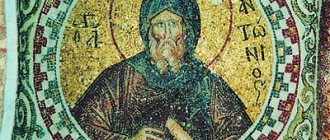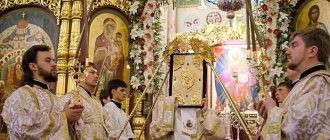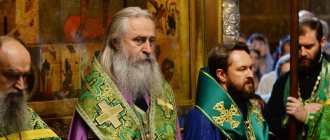Passion in Orthodoxy
Literally, the word “passion” is translated as sorrow and suffering. In everyday life it is used to mean “falling in love” and “unrequited love.” In the church it has a different meaning and is not at all connected with the loving suffering of Christ.
Passion is a special service during Lent, in which all prayers are dedicated to the suffering and death of Jesus on the cross. From the Church Slavonic language the word “passion” is translated as “passion”.
Passion is served only at the end of winter and spring, depending on the time of Lent. At this time, the priests conduct all funeral services, even on Sunday.
The black clothes they dress in symbolize mourning, a time of suffering.
Please note: Passions are served only on Sunday evenings.
What is Passion for Lent?
Lent is a special time for every Christian. This is the longest fast of the year, dedicated to the suffering of Jesus Christ and his Resurrection.
This is the strictest fast, during which you cannot even eat fish. It is considered the heaviest, and not only because in spring there are not enough vitamins and bright colors. Simply, Lent is a time of worship dedicated to the suffering of Christ.
The exact start time has not been recorded. Every year Lent begins differently. It is believed that it depends on the lunar cycle. Therefore, every year it begins at a different time - immediately after Maslenitsa, celebrated in February, and sometimes in March.
Typically, Sunday is considered a holiday dedicated to Jesus Christ. If in Judaism Saturday was considered a day off, then Christians made Sunday a holiday, but the meaning of this day changes during Lent. At this time, Sunday becomes a reminder of the suffering of Christ, so passion is served in the evening.
In total, 4 passions are served every Sunday during Lent. But since in some churches the holiday of the Triumph of Orthodoxy is celebrated on the first Sunday, the Passion is not always served on the first Sunday. But during Lent, 4 passions are read in honor of the 4 Gospels, then Palm Sunday is celebrated the next Sunday, followed by Easter.
It is worth noting: in some churches the last passion is read not on Sunday, but on Friday.
There is an opinion that Passion is a late service borrowed from Catholics, but this is not true. The solemn and pathetic nature of the Catholic service has nothing to do with the Orthodox one. It is for this reason that at the beginning of the appearance of passion (15th century) it caused a lot of controversy and almost a schism in Orthodoxy, but today passion is considered a generally accepted worship service that does not raise any doubts about its correctness.
The Orthodox passion, in contrast to Catholic worship, is more strict and modest, in which every Christian internally experiences all the sufferings of Christ, sympathizes with Him, and does not show off his emotions.
Please note: this service is very strict, so you should not come to church in bright, provocative or festive clothes, as this contradicts the strict and mournful nature of the service. Bright perfume and provocative makeup are undesirable.
Priest Vadim Korzhevsky. Passion - non-statutory worship and an experience alien to us
Parishioner. Tell me, on what day and what time will you serve your passion?
Presbyter. Passions are not performed in our church.
Parishioner. How?! At all?
Presbyter. Why should they be done?
Parishioner. But Lent is coming.
Presbyter. Yes, I know.
Parishioner. Shouldn’t passions be celebrated during Lent?
Presbyter. They should not be performed in our worship services at all, especially during Great Lent.
Parishioner a. What a news! And why?
Presbyter. Because there is no indication of its existence in the Charter of the Orthodox Church.
Parishioner. Where did this service come from?
Presbyter. The order of this “divine service” was compiled in the middle of the 17th century by Kiev Metropolitan Peter (Mogila).
Parishioner. And who is it? You have mentioned his name more than once and in a not very favorable light.
Presbyter. This is the author of the “Confession of the Orthodox Faith”, compiled according to Latin books and diagrams [1], as well as the famous and very popular Great Breviary (Euchologion), in which individual rites and sequences are accompanied by explanatory articles taken from the Roman “Ritual” of Pope Paul Vth. From this alone it is already clear that he handled Latin books quite freely, and, what is saddest for us, “what he found in them, he took for Orthodoxy, like an ancient tradition”[2].
Parishioner. So, passion is also a Latin rite?
Presbyter. Without a doubt. You can be convinced of this by learning not only about its origin, but also from the very spirit that it contains.
Parishioner. Can we do this now?
Presbyter. Let's try. As you know, passions are performed 4 times a year: on the second, third, fourth and fifth Sundays of Lent, although there is a practice of performing them on other days of the week: Wednesday or Friday. Translated from Latin, passio means passion, suffering. And as is clear from the name itself, these services remember the saving suffering of the Lord Jesus Christ. For each passion, stories about it are read in turn from each Gospel. Chants from the Good Friday service are sung. And at the very end, a sermon is preached teaching about the Atonement.
Parishioner. And the akathist?
Presbyter. Later, to all of the above, they also added the singing of an akathist to the Passion of the Lord. But he was not in the early ranks. Initially, passions were common only in the southern regions of Russia, and only by the 20th century they began to be performed everywhere in our Church.
Parishioner. That is, until the 20th century, passions were not committed in our country?
Presbyter. Imagine. And none of the saints I know even discussed this topic, except for St. Athanasius, who limited himself to saying that the passions borrowed from the Latins do not fully correspond to the spirit of the Orthodox Church Charter[3].
Parishioner. What's wrong with them? After all, the service of passions helps us achieve the ultimate goal of Great Lent - co-crucifixion with Christ - and better prepare for the Easter holiday!
Presbyter. Did you come up with this yourself or did someone suggest it?
Parishioner a. I learned this from passion sermons.
Presbyter. I thought so. But I’m afraid that you and those who told you this are deeply mistaken.
Parishioner. Explain.
Presbyter. First, let's talk about co-crucifixion. As far as I understand, when you use this term, you mean a certain feeling for the suffering Christ. Right?
Parishioner. Not a certain, but a specific feeling of compassion. The whole situation at the passion is conducive to vividly grieving over human injustice and the terrible torment of Christ. This is why I like passions.
Presbyter. Are you not alarmed by the fact that crucifying with Christ, empathizing with His agony on the cross, is perhaps the most essential thing in the Western ascetic practice of imitation of Christ and that the main “virtue” of Catholic saints is “compassio”, i.e. torment with Christ, expressed by absorption in His external suffering, even to the point of stigmatization?
Parishioner. What is stigma?
Presbyter. Stigmatization is, as it were, materialized compassion for Christ. Stigmata literally translated from Greek means an injection, a mark. Stigmata are constantly bleeding ulcers that appear on the body of ascetics at the places of Jesus Christ’s suffering on the cross, i.e. on the head, chest, palms and feet. These wounds, according to experts, appear when the conscious life is completely absorbed by some vivid image, accompanied by a powerful mental suggestion that seeks to transfer the suffering of the imaginary image into the physical sensations of the body[4]. According to St. Ignatius Brianchaninov, the efforts of Western ascetics boil down mainly to “reviving feelings, blood and imagination”[5]. They especially love to do this when remembering the earthly suffering of Christ. The first stigmatist, Francis of Assisi[6], according to biographers, “intoxicated with love and compassion for Christ, sometimes lifted a piece of wood from the ground and, taking it in his left hand, moved it with his right in the manner of a violin bow, singing the French song about the Lord Jesus Christ,” which ended with tears of pity for the suffering of Christ and intense sighs[7]. He was the first to assert that the degree of holiness is determined by the degree of suffering at the sight of the crucified Christ[8].
Parishioner. I didn’t know this, although I had heard something vaguely about it.
Presbyter. The author of the film “The Passion of the Christ” strives for the same goal.
Parishioner. So, is this movie bad?
Presbyter. The question is incorrect, because the concepts of “bad” and “good” are relative concepts. Remember the joke: what is good for a Russian is death for a German. What is useful to one may not be useful to another. In some cases, poison can be useful... But there is no doubt that this film is made in the best traditions of Catholic spirituality.
Parishioner. Well, I don’t know, I liked the film, and I’m not the only one...
Presbyter. Didn’t you think that he was overly natural and sometimes cruel to the viewer?
Parishioner. Yes, I agree that for those who, for example, have a weak nervous system, this film may be harmful. But overall the film is amazing!
Presbyter. So you have answered your own question. This film is a shocker to the nervous system. But what does spiritual life have to do with it? On this subject, I remember, there is an interesting letter from St. Ignatius. I'll look for it now... And here it is. Look, here is a description of the film we are discussing and a recommendation for how to approach it: “Do not read (in our case, do not watch) any heterodox writers: they have replaced the Holy Spirit with unbridled, fiery blood; they can lure people into the abyss - and they lure many people there. The “action” you mention, produced in you by reading Scripture (watching a film) - what impression did the distant sounds of hammers striking the nails during the crucifixion of the Savior have on John the Theologian and the Myrrh-Bearers (how terribly painful was the Savior at that time and what inhuman torments He endured for the sake of us), it was “bloody”. Understand: my nerves were shaken. Such actions are rejected in spiritual feat and are called “delightful,” i.e. originating from self-delusion and leading to it, because they are not from the grace of God, but our own human condition, characteristic of our fallen nature, which is reached by the strain of imagination and sensitivity”[9]. Is it good? According to him, this is very bad, because it creates the ground for self-delusion. To prevent this from happening, “you must keep yourself in a state of evenness, silence, calm, poverty of spirit, carefully moving away from all conditions produced by heated blood and nerves”[10].
Parishioner. What then does St. mean? ap. Paul, when he says: “I have been crucified with Christ, and it is no longer I who live, but Christ who lives in me”? (Gal.2:19-20)
Presbyter. This is not at all what Catholics and their sympathizers mean. Christ must be crucified not through the desire to get used to His state and feel mentally or sensually what He felt during His crucifixion, but through the mortification of passions. In co-crucifixion with Christ, our old man is crucified with Him in the baptismal font, freed from sins (Rom. 6:3-7), so that man ceases to do what is displeasing to God.
Parishioner. Thanks for clarifying.
“Holy Fire” March 26, 2021
[1] When compiling it, he used the “Roman Catechism” and the “Summa” (larger Catechism) of Peter Canisius, as well as the small Catechism of P. Soto and other works.
[2] Florovsky Georgy, prot. Paths of Russian theology. Minsk. 2006. P. 48.
[3] St. Athanasius (Sakharov). About the remembrance of the dead. Note No. 141.
[4] J. Dumas // Ladyzhensky M.V. The Invisible Light. – M., 1998. P. 186–187.
[5] St. Ignatius Brianchaninov. Collection of letters. No. 163 (255, 32). P. 322.
[6] Years of life: 1182–1226
[7] See: Ladyzhensky M.V. The light is invisible. P. 199.
[8] See: Flowers of St. Francis of Assisi. Ch. 44. – M., 1990.
[9] St. Ignatius Brianchaninov. Collection of letters. No. 158. P. 286.
[10] Ibid. P. 286.
Passion course of service
During the Passion, the main point is reading the Gospel. There are 4 of them in total. This service is very strict and in some churches it is customary to stand with lit candles throughout the entire passion. At this time, mournful chants are heard, and then the Gospel is read.
During the service, there is a Crucifix in the middle of the temple, which everyone comes up to after the service and kisses.
The main prayers of the passion are dedicated to the suffering of Christ. During the service, the services of Friday, the day of the end of Christ’s earthly life, are also read. All prayers are dedicated to the suffering of Christ and Golgotha, events that are associated with the last days of Jesus’ earthly life.
Passion as an element of worship of the Russian Orthodox Church
The document was adopted at a meeting of the Holy Synod on May 30, 2019 (magazine No. 53).
Special fasting services dedicated to the veneration of the Passion of the Lord Jesus Christ and called passions have become widespread in the Russian Orthodox Church. At the same time, the pursuit of passion is not described in the modern Typikon, and therefore there are numerous different practices for its implementation. This document formulates recommendations regarding the practice of the celebration of passion, and provides instructions aimed at bringing uniformity to the observance of this service.
The celebration of passions was first approved by the Council of the Kyiv Metropolis, held in 1629 under the chairmanship of Metropolitan Job (Boretsky) of Kyiv and Galicia, the defender of Orthodoxy in the fight against the union. In 1702, the rite of passion was first published in the Kiev Pechersk Lavra. According to this rite, passion was celebrated as part of Compline. In this original version, the passion consisted of the Gospel reading about the Passion of the Savior, the singing of the stichera of Holy Heel and Holy Saturday, as well as a sermon. The practice of celebrating passions at Compline is still preserved within the Ukrainian Orthodox Church.
In the middle of the 19th century, Saint Innocent of Kherson composed a service with an akathist to the Divine Passion of Christ. It was intended both for private prayer use and for performance in churches, following the example of the rite of worship with an akathist adopted in the Kiev Pechersk Lavra. The Akathist, as edited by St. Innocent, was published several times during the 19th and 20th centuries by Synodal printing houses. Since the beginning of the 20th century, the akathist to the Divine Passion of Christ began to be included in the rites of the passion.
During the years of persecution, passions became more widespread, while the diversity of customs for their implementation remained. In particular, in the practice of Moscow and St. Petersburg parishes, the custom has been established to perform passion at evening services on Sundays of Great Lent, which is today the most widespread in the Russian Orthodox Church.
This custom allows parishioners who are at work on weekdays to spiritually participate in the events of the Passion and be imbued with the words of the Gospel. Many outstanding preachers used the Gospel readings of passions as an occasion to address those who came to church with a word of edification.
Although the theme of the Passion is heard in daily Lenten services - in the touching penitential stichera, in the troparia of the Lenten hours, in the Old Testament prophecies, the celebration of passion in parishes on Sundays allows those believers who do not have the opportunity to attend daily services to immerse themselves in the experience of the Passion of Christ.
According to the number of Evangelists, four passions are usually celebrated in parish and monastic practice, which makes it possible for those praying to fully hear the biblical narrative of our Redemption at the passions. A person receives great benefit if he listens attentively to the word of the Gospel. And the gospel of our salvation is capable of turning the human soul around, turning a person to repentance.
Therefore, pastors should accompany the ministry of passions with a sermon that reveals the meaning of the most sacred pages of the Gospel and actualizes the missionary potential of these services.
Diocesan Right Reverends should take care of establishing uniformity in the order of serving the passion in those parishes and monasteries where the custom of their service has developed, guided by one of the following schemes, but the performance of passion should not be considered obligatory.
Appendix (possible schemes for committing a passion)
I. Committing a passion with an akathist
On Sunday evening, a Crucifix and a lectern under the Gospel are placed in the middle of the temple.
At Vespers, when singing the stichera “To you, who dress...” to “And now...” at the end of the verse stichera, the clergy proceeds through the royal doors to the lectern in front of the Crucifixion. The Primate carries the Gospel. The entire incense of the temple is performed.
At the end of the stichera and incense, an akathist to the Divine Passion of Christ is sung or read.
At the end of the akathist, the prokeimenon “Having divided My garments for myself...” is read, after which the Gospel is read, preceded by the proclamation “And may we be honored...”. Before reading the Gospel, the choir sings: “Glory to Your Passion, Lord.”
- on the 1st Passion the Gospel of Matthew is read, conception 107–114 (or only 110–114);
- on the 2nd Passion the Gospel of Mark is read, conception 63–69 (or only 66–69);
- on the 3rd Passion the Gospel of Luke is read, conception 108–111 (or only 110–111);
- on the 4th Passion the Gospel of John is read, conception 58–62 (or only 60–62).
After reading the Gospel, the choir sings: “Glory to your long-suffering, Lord” and the antiphon “Today hangs on the tree...”.
After the singing of the antiphon, a special litany and prayer to the Lord Jesus crucified from the akathist are said.
The choir sings the stichera “Come, let us please Joseph of ever-memorable...”. The clergy worships the Cross and goes to the altar.
Then “Now you let us go…” is read and the usual end of fasting vespers on Sunday evening is performed.
After the singing of the antiphon “Today hangs on the tree...” or after the dismissal of Vespers, a sermon is preached about the suffering of the Savior.
II. Committing a passion without an akathist
On Friday evening at Great Compline, after “Glory to God in the highest...”, the choir sings the stichera “For You Who Cloth...”. During the singing of the stichera, the clergy proceeds through the royal doors to the lectern in front of the Crucifixion. The Primate brings out the Gospel. The entire incense of the temple is performed.
At the end of the stichera and incense, “And may we be honored...” is proclaimed, after which the Gospel is read. Before reading the Gospel, the choir sings: “Glory to Your Passion, Lord!”
- on the 1st Passion the Gospel of Matthew is read, conception 107–114 (or only 110–114);
- on the 2nd Passion the Gospel of Mark is read, conception 63–69 (or only 66–69);
- on the 3rd Passion the Gospel of Luke is read, conception 108–111 (or only 110–111);
- on the 4th Passion the Gospel of John is read, conception 58–62 (or only 60–62).
After reading the Gospel, the choir sings: “Glory to your long-suffering, Lord.”
A sermon is preached about the suffering of the Savior.
The choir sings the stichera “Come, let us please Joseph of ever-memorable...”. The clergy worships the Cross and goes to the altar.
This is followed by the Trisagion, “Lord of Hosts...” and the usual end of Compline.
Official website of the Moscow Patriarchate
Gospels read at Passion
In Passion the 4 Gospels are read. At the first Passion, the Gospel of Matthew is read - chapters 26 and 27, dedicated to the suffering of Christ and the end of his earthly life. They describe the betrayal of Judas, the suffering of Christ and everything that happened afterwards.
During the next Passion, chapters 14 and 15 of the Gospel of Mark are read in church.
Chapters 23 and 22 of the Gospel of Luke are usually read during Passion 3, and during the last Passion, which occurs on Friday or Sunday, chapters 18 and 19 of the Gospel of John are read.







